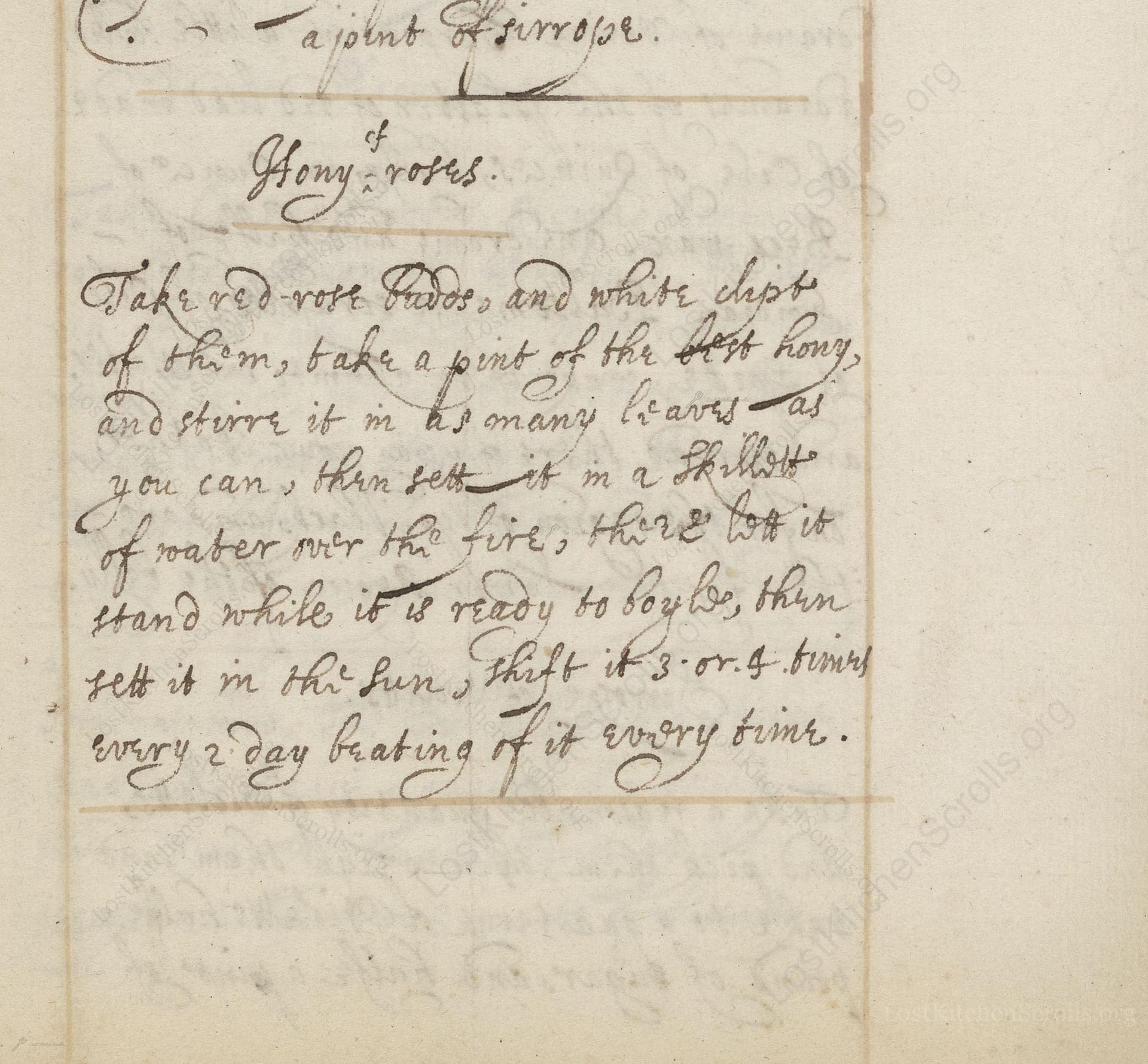
Hony
"Take red rose Leaves, and white clips of them, take a pint of the best hony, and stirre it in as many Leaves as you can, then sett it in a Skillett of water over the fire, there lett it stand while it is ready to boyle, then sett it in the sun, shift it 3 or 4 times every 2 day heating of it every time."
Note on the Original Text
Historical recipes were typically written as brief instructions, assuming the reader possessed basic kitchen knowledge, and only included key actions—here, mixing, heating, and sunning. The spelling and punctuation reflect early modern English: 'boyle' for 'boil,' and 'Lett it stand' for 'let it stand.' The instruction to 'shift it' refers to rewarming the mixture, a step at once preserving and concentrating the flavors. Directions are imprecise by modern standards but reveal the hands-on, improvisational approach of the period.

Title
Receipt book of Sarah Longe (1610)
You can also click the book image above to peruse the original tome
Writer
Sarah Longe
Era
1610
Publisher
Unknown
Background
A delightful glimpse into early 17th-century kitchens, this collection by Sarah Longe whisks readers through ancestral recipes, cooking tips, and the seasonings that graced the tables of Jacobean England. Prepare to savor the tastes and traditions of times gone by.
Kindly made available by
Folger Shakespeare Library
This recipe hails from early 17th-century England and is attributed in a household manuscript to Sarah Longe around 1610. During this period, sugar was costly, and honey was a treasured sweetener, often infused with botanicals for both culinary and medicinal purposes. Conserves of flowers, such as roses, were enjoyed as sweets, used to flavor desserts, or taken for health, especially to 'comfort the heart.' This method of gently infusing honey with aromatic petals, and exposing the mixture to sun and gentle warmth, reveals both the practical knowledge and the poetic sensibilities of early modern cooks.

In the early 1600s, this recipe would have been made with a simple earthenware or metal bowl, a skillet (shallow pan) for heating water, and wooden spoons or paddles for stirring. The bain-marie technique—a bowl in simmering water—gently heated delicate ingredients without burning. To expose the mixture to sunlight, cooks might use wide, shallow dishes set on window ledges or garden tables, covered with linen to protect against dust and insects.
Prep Time
10 mins
Cook Time
15 mins
Servings
16
We've done our best to adapt this historical recipe for modern kitchens, but some details may still need refinement. We warmly welcome feedback from fellow cooks and culinary historians — your insights support the entire community!
Ingredients
- 1 pint (approx. 1½ lb) best-quality runny honey
- 3+ large handfuls (about 1–1.4 oz) fresh unsprayed red rose petals (or substitute with edible, fragrant garden rose petals)
- Optional: small amount of white petal bases or extra white rose petals (if not available, simply use more red rose petals)
Instructions
- To make this honeyed rose conserve, begin by gathering fresh unsprayed red rose petals (and if available, white petal bases), enough to loosely fill a bowl.
- Weigh out approximately 1 pint (about 1½ lb) of high-quality runny honey.
- Gently mix in as many rose petals as possible until the honey is thick with petals and nearly saturated.
- Pour the mixture into a heatproof bowl or jar and place this into a saucepan (or skillet) of simmering water, creating a bain-marie.
- Warm gently, just until the honey is almost ready to boil—do not allow it to actually boil.
- Remove from the heat and place the jar in a sunny window or outdoors, covered with muslin to keep out insects.
- Every two days, bring the mixture back over gentle heat as before, then return it to the sun.
- Repeat this process 3 or 4 times over about a week.
- Once done, store in a clean jar and use as a luxurious floral sweetener.
Estimated Calories
60 per serving
Cooking Estimates
You will spend a short amount of time gathering and preparing the rose petals and honey. Most of the time is passive: periodically you will gently heat the mixture and let it infuse in the sun over several days. Each step only takes a few minutes.
As noted above, we have made our best effort to translate and adapt this historical recipe for modern kitchens, taking into account ingredients nowadays, cooking techniques, measurements, and so on. However, historical recipes often contain assumptions that require interpretation.
We'd love for anyone to help improve these adaptations. Community contributions are highly welcome. If you have suggestions, corrections, or cooking tips based on your experience with this recipe, please share them below.
Join the Discussion
Rate This Recipe
Dietary Preference

Den Bockfisch In Einer Fleisch Suppen Zu Kochen
This recipe hails from a German manuscript cookbook compiled in 1696, a time whe...

Die Grieß Nudlen Zumachen
This recipe comes from a rather mysterious manuscript cookbook, penned anonymous...

Ein Boudain
This recipe comes from an anonymous German-language manuscript cookbook from 169...

Ein Gesaltzen Citroni
This recipe, dating from 1696, comes from an extensive anonymous German cookbook...
Browse our complete collection of time-honored recipes



